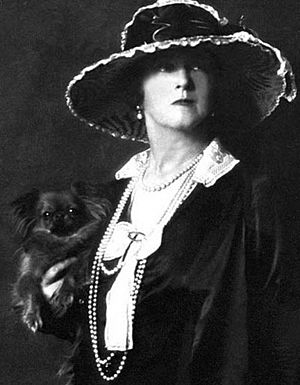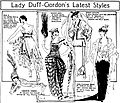Lucy, Lady Duff-Gordon facts for kids
Quick facts for kids
Lucy, Lady Duff-Gordon
|
|
|---|---|

Lucile,
photographed by Arnold Genthe |
|
| Born |
Lucy Christiana Sutherland
13 June 1863 London, England
|
| Died | 20 April 1935 (aged 71) London, England
|
| Spouse(s) | |
| Children | Esme Giffard, Countess of Halsbury |
| Relatives | Elinor Glyn (sister) Tony Giffard, 3rd Earl of Halsbury (grandson) |
| Nationality | English |
|
Label(s)
|
Lucile Ltd. |
Lucy Christiana, Lady Duff-Gordon (born Sutherland; 13 June 1863 – 20 April 1935) was a very important British fashion designer. She was famous in the late 1800s and early 1900s. She used the professional name Lucile for her designs.
Lucile was the first British designer to become famous all over the world. She was known for creating new styles in high fashion. She also changed how fashion was shown to the public. She invented the "mannequin parade," which was like the first modern fashion show. She also trained the first professional fashion models. Lucile introduced new clothing styles like slit skirts and low necklines. She also made corsets more comfortable and promoted beautiful, simpler lingerie.
Her company, Lucile Ltd, started in London and opened branches in Chicago, New York City, and Paris. This made it the first global fashion brand. She dressed many famous people, including royalty, nobles, and stars from the stage and movies. Lady Duff-Gordon is also remembered for surviving the sinking of the RMS Titanic in 1912. She was also part of a famous contract law case in 1917, called Wood v. Lucy, Lady Duff-Gordon. This case helped set new rules for how contracts work.
Contents
Early Life and Adventures
Lucy Christiana Sutherland was born in London, England. Her father was Douglas Sutherland, a civil engineer. Her mother was Elinor Saunders. After her father died, Lucy was raised in Guelph, Ontario, Canada.
In 1871, her mother remarried, and Lucy moved with her family to Saint Helier on the Isle of Jersey. Lucy loved fashion from a young age. She dressed her dolls, studied gowns in family paintings, and made clothes for herself and her sister, Elinor Glyn. In 1875, Lucy and Elinor survived a shipwreck when their boat hit the ground in a storm.
Family and Marriages
In 1884, Lucy married James Stuart Wallace. They had a daughter named Esme (born 1885). Esme later became the wife of the Earl of Halsbury. Lucy and James Wallace separated around 1890, and their divorce was completed in 1895.
In 1900, Lucy married Sir Cosmo Duff-Gordon, a Scottish baronet and sportsman.
Becoming a Fashion Icon
After her first marriage ended, Lucy Duff-Gordon started making dresses from home to support herself and her daughter. In 1893, she opened her first shop, Maison Lucile, in a fashionable part of London. Her business grew, and she moved to larger shops over the years.
In 1903, her company became "Lucile Ltd." The next year, it moved to 23 Hanover Square, where it stayed for 20 years. Lucile Ltd dressed many rich and famous clients, including royalty and theater stars. The business grew even more, opening salons in New York City (1910), Paris (1911), and Chicago (1915). This made it the first major fashion house with branches in three different countries.
Lucile was most famous for her beautiful lingerie, tea gowns, and evening wear. Her designs often used soft fabrics in light, blended colors. They were often decorated with handmade silk flowers. Lucile also made simple, smart suits and clothes for daytime. The dress shown in the picture is a good example of her classic draped style.
Lucy Duff-Gordon is also known for training the first professional fashion models, who were called mannequins. She also created the first "catwalk" style fashion shows. These shows were like theater performances. They were by invitation only and included a stage, curtains, special lighting, music, and even gifts for guests.
Another new idea she had was her "emotional gowns." These dresses were given special names that came from books, history, and popular culture. The names also reflected the personality of the person who would wear the dress.
Many famous clients wore Lucile's designs. Their clothes were seen in early films, on stage, and in newspapers. Lucile also designed costumes for many plays and movies. These included the London show of The Merry Widow (1907) and the silent movie Way Down East (1920). Lucile's creations were often shown in newsreels in the 1910s and 1920s. Lucy Duff-Gordon even had her own weekly spot in a British newsreel.
Lucile Ltd had sketch artists who drew her designs. As she became busier, especially during World War I, other artists helped her. These artists created ideas based on the "Lucile look." Many of their drawings were published and signed "Lucile." Lucy Duff-Gordon always approved these designs.
Lucy Duff-Gordon also wrote about fashion. She had a weekly fashion page in the Hearst newspaper syndicate from 1910 to 1922. She also wrote monthly columns for Harper's Bazaar and Good Housekeeping. Her designs were also often shown in popular fashion magazines like Vogue.
Besides designing and writing, Lucy Duff-Gordon also used her name to promote other products. She advertised brassieres, perfume, shoes, and other luxury items. She even designed a cheaper clothing line for Sears, Roebuck & Co. and interiors for cars.
The Titanic Disaster
In 1912, Lucy Duff-Gordon traveled to America for her fashion business. She and her husband, Sir Cosmo, booked first-class tickets on the ocean liner RMS Titanic. Her secretary, Laura Mabel Francatelli, traveled with them.
On April 14, 1912, the Titanic hit an iceberg and began to sink. During the evacuation, the Duff-Gordons and their secretary escaped in Lifeboat No. 1. This lifeboat was meant to hold 40 people, but it was lowered with only 12 people on board. Seven of these were male crew members.
After the Titanic sank, while in the lifeboat, Lucy Duff-Gordon reportedly said to her secretary, "There is your beautiful nightdress gone." A fireman in the boat was upset by this comment. He said that while the Duff-Gordons could replace their things, he and the other crew members had lost everything. Sir Cosmo then offered each of the men £5 to help them until they found new jobs.
Later, on the RMS Carpathia, the ship that rescued the Titanic's survivors, Sir Cosmo gave the men cheques from his bank. This led to rumors that the Duff-Gordons had paid the lifeboat crew not to go back and rescue more people. People thought they were afraid the boat would be too full.
These rumors were spread by newspapers. In May, Sir Cosmo and Lady Duff-Gordon testified at the official inquiry into the disaster in London. Their testimony drew large crowds.
The inquiry found that the Duff-Gordons did not stop the crew from trying to rescue others. Lucy Duff-Gordon later said that her husband was heartbroken for the rest of his life because of the negative newspaper stories.
In 2012, a box of documents about the Titanic sinking belonging to the Duff-Gordons was found. It included a list of Lucy Duff-Gordon's lost possessions, valued at over £3,200. One letter described what she wore when leaving the ship: two dressing gowns, a muff, and her "motor hat."
Another Close Call: The Lusitania
Lucy Duff-Gordon had another close call three years after surviving the Titanic. She had booked a ticket for the final voyage of the RMS Lusitania. However, she canceled her trip because she was ill. The Lusitania was sunk by a German torpedo on May 7, 1915.
A Landmark Legal Case
In 1917, Lucy Duff-Gordon was involved in a famous court case called Wood v. Lucy, Lady Duff-Gordon. This case was heard by the New York Court of Appeals. Judge Benjamin N. Cardozo made an important decision about contract law. He ruled that Lucy Duff-Gordon had a contract with her advertising agent, Otis F. Wood. This contract gave Wood the only right to market her professional name, "Lucile." Even though the contract didn't clearly state what she would get in return, the judge said that the whole agreement showed there was a contract. This case helped define how contracts can be understood even if they don't spell out every detail.
Later Years and Legacy
Lucy Duff-Gordon's connection to her fashion company began to change after 1918. She publicly admitted that she was not designing many of the dresses sold under her name. By 1922, she stopped designing for the company, and it eventually closed.
She continued to work as a fashion columnist and critic. She wrote for London newspapers like the Daily Sketch. In 1932, she wrote her autobiography, Discretions and Indiscretions.
Lucy Duff-Gordon died in London in 1935 at the age of 71. She passed away from breast cancer and pneumonia. Her death was on the fourth anniversary of her husband's death.
Lucy Duff-Gordon left a big mark on fashion, history, and law. She helped create the idea of the 'It girl' with her sister, Elinor Glyn.
Museum Exhibitions
Many museums around the world have shown Lucile's clothing. Some of these include:
- The Metropolitan Museum of Art's "Cubism and Fashion" (1999)
- The Museum of the City of New York's "Fashion on Stage" (1999)
- The Victoria and Albert Museum's "Black in Fashion" (2000)
- The first exhibition just about Lucile's work was "Designing the It Girl: Lucile and Her Style" (2005) at the New York Fashion Institute of Technology.
- As of 2006, the V&A Museum has a Lucile suit on permanent display.
Fashion Today
- In 2011–12, Lucy Duff-Gordon's great-great-granddaughter, Camilla Blois, brought back the Lucile brand. It now focuses on lingerie.
Television Features
- The Sundance Channel documentary, Love, ... & Lingerie (2012), featured Lucile's contributions to fashion.
- The ITV1 miniseries Titanic (2012) included a character based on the designer.
- Lucile is mentioned in Downton Abbey, season 3 (2012–2013).
- She is also mentioned in the series Mr. Selfridge (2013–2014).
- She was featured in a short historical segment on The Great British Sewing Bee (2016).
Titles Held
- 1863–1884: Miss Lucy Christiana Sutherland
- 1884–1900: Mrs. James Stuart Wallace
- 1900–1935: Lucy, Lady Duff-Gordon
Images for kids
See also
 In Spanish: Lucy Duff-Gordon para niños
In Spanish: Lucy Duff-Gordon para niños




